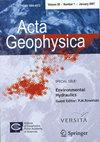Structure of the lithosphere beneath Cameroon using global gravity model data: implications for the setting of the Cameroon Volcanic Line
Abstract
In this study, XGM2019e_2159 global gravitational model data are used to investigate the intracrustal structure beneath Cameroon. The work focuses on the mantle region that promoted the formation of the Cameroon Volcanic Line (CVL) and above all, appreciates the geodynamic interaction between these two particular geological entities. The approach is based on the use of digital filters for qualitative and quantitative interpretations. The data were first processed using the upward continuation filter that reveals several zones of gravity gradients, which are persistent at various depths and that can be interpreted as the vertical extension of major geological feature limits. The (2D) analysis of the frequency spectrum of the global gravity model anomalies (XGM2019e_2159) was performed to estimate the crustal thickness of the aligned volcanic regions located in Cameroon and Congo Craton (CC). The use of 2D1/2 modelling applied on 5 profiles reveals the lateral and vertical extension of the discordance of geological structures. The presence of a mafic layer with thicknesses ranging between 6 and 22 km is persistent beneath the Kribi-Campo area, the Congo Craton and the Pan-African chain. Models also suggest a crustal thinning process at the northern border of Congo Craton which may have provoked the sliding of some fragments of the crust in the Pan-African domain migrating towards the CVL. The results obtained also reveal the identity of a complex and multi-fractured tectonic context and that the CVL and the CC are not only of mantle origin but also have a mantle interconnection.

 求助内容:
求助内容: 应助结果提醒方式:
应助结果提醒方式:


